
Air and Space Museum thrills visitors
WASHINGTON, D.C.— The cool, dark and rough surface glides under the little boy’s small hand. As his hand runs over each little crevice, his eyes begin to glisten with wonder as he stares at the foreign object.
“Look Daddy! I’m touching the Moon! I told you I could be an astronaut!” Matthew Brice squealed with delight as he touched a Moon rock on the first floor of the Smithsonian’s National Air and Space Museum.
Who knew that the vast world and history of flight could land right on the National Mall where some 50,000 artifacts make up the world’s largest collection of historic aircraft and spacecraft?
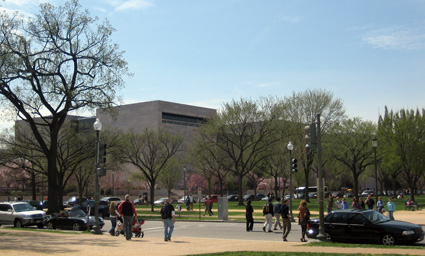 |
The National Air and Space Museum is located on the National Mall (Photo by Danielle Cohn). |
It is there that such young dreamers have made their dreams a reality and are showcasing their achievements to the world in an unforgettable way.
Space never felt so close as it does standing next to the actual Apollo 11 Lunar Module “Eagle” only to hear Linda Perry from Orlando read aloud the famous line Neil Armstrong quoted upon landing on the moon in 1969, “Houston, Tranquility Base here. The Eagle has landed.”
From the very first flying contraption to the latest SpaceShipOne that is taking space travel where it has never gone before, there are 22 exhibition galleries that are being showcased at the museum and are always being updated with new additions from NASA or from the actual pilots themselves.
In fact, Anne Miller, docent for the National Air and Space Museum, told a story about Charles E. Yeager, also known as “Chuck” who was the captain of the Bell X-1 Glamorous Glennis (the first aircraft to travel faster than the speed of sound.
She says Yeager told the museum, which displays the same airplane right at its entrance on the first floor, that if officials didn’t change the paint of the gray jet back to its original orange, since that was its color when it was first flown, he would come to the museum himself with a ladder and paint it himself.
Being known to be a man of his word, the museum swiftly made the changes to the airplane and it can be seen today in its beautiful bright orange hue.
Since this museum is such an enormous facility and is only one of the National Air and Space Museum’s two large display facilities (the other one is the Stephen F. Udvar-Hazy Center in Chantilly, Va.), there are certain galleries that visitors should see depending on how much time can be spent in the museum.
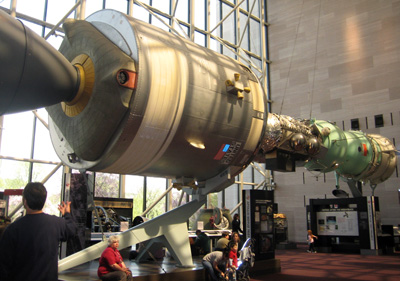 |
The Apollo-Soyuz capsuls exhibit in the Ntional Air and Space Museum (Photo by Danielle Cohn). |
Visitors pressed for time should make a point of seeing the museum’s three major galleries on the first floor, which are Milestones of Flight (Gallery 100), Air Transportation (Gallery 114), and Space Race (Gallery 114).
The Milestones of Flight gallery holds the biggest collection of treasures in the Museum. Magnificent planes— including Yeager’s Bell X-1 and Charles Lindbergh’s Spirit of St. Louis as well as historic space craft such as John Glenn’s Mercury capsule Friendship 7 and the Apollo 11 command module Columbia— crowd the ceiling and floor, captivating each new visitor that enters the building.
“Oh my God,m John, look at the bottom of this thing, it’s completely eroded,” said Kate Timmelton, from Ohio to her husband as she stared at the completely glass- enclosed Gemini IV spacecraft, which held astronaut Edward H. White II on June 3, 1965, when he became the first American to perform an Extra Vehicular Activity (EVA) or “spacewalk.”
It is in this gallery that visitors like young Brice can touch an authentic Moon rock as well as see the newest addition to the gallery: SpaceShipOne, the first privately developed, piloted vehicle to reach space.
The second noteworthy gallery to see is the Air Transportation. This is really a time capsule of 1920s and 1930s air transportation: a Pitcairn PA-5 Mailwing, Ford 5-AT Tri-Motor, Boeing 247-D, Douglas DC-3 and many others.
The Space Race gallery is the third must-see and a very interesting multi-media filled area that should not be missed. Here lies the story of the U.S.-Soviet competition for “firsts” in space.
| The Skylab exhibit of the National Air and Space Museum (Photo by Danielle Cohn). | 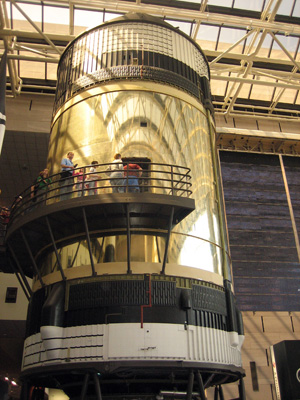 |
Miller talked about the first Soviet satellite, Sputnik 1, that the Soviet Union launched on Oct. 4, 1957, that went around the world and could be seen from the earth.
“It was a little shiny thing moving across the sky and scared the living daylights out of everyone,” Miller said with a chuckle.
This is when the U.S. decided to create NASA and in January 1958 the U.S. launched the Explorer 1, their own version, which proved to be the U.S.’s first successful satellite and this officially started the space race, Miller further explained.
On display are a German V-1 and V-2 and a cluster of other rockets and missiles, U.S. and Soviet space capsules, and a full-scale test model of the Hubble Space Telescope. Visitors can even enter a section of the Skylab space station for viewing.
In addition visitors can view the actual space suits worn by John Glenn and the Soviet Yuri Gagarin, learn how the space shuttle has developed through the years and see miniature models displaying its transformation, learn what living in space is like and even get the answer to the popular question, “How do astronauts go to the bathroom in space?”
If one has a little more time, then definitely make room for The Wright Brothers & The Inventions of the Aerial Age in Gallery 209.
Visitors can learn who the Wright brothers were, how they invented the airplane, and how the world responded to it in this area.
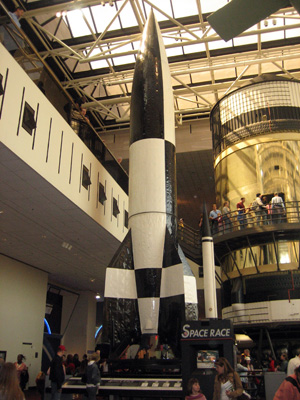 |
The Space Race Gallery of the National Air and Space Museum (Photo by Danielle Cohn). |
“Wow that guy flew on that? It looks too light to hold him, what is it made out of?” asked Jason Stocks, who stared at the original 1903 Wright Flyer only a few feet away.
Miller answered in full.
“The 1903 Wright Flyer was constructed of spruce and ash covered with muslin. The framework “floated” within fabric pockets sewn inside, making the muslin covering an integral part of the structure. This ingenious feature made the aircraft light, strong and flexible. And it was powered by a simple four-cylinder engine of the Wrights’ own design.
“But to fly the airplane, the Wright had to lay prone with his head forward, his left hand operating the elevator control. Lateral control was achieved by warping the wing tips in opposite directions via wires attached to a hip cradle mounted on the lower wing. The pilot shifted his hips from side to side to operate the mechanism, which also moved the rudder. You had to be in good physical condition to do it,” said Miller.
After seeing the main highlights of the museum, it is time to pick a special interest. Do you fancy Old Aircraft, Military Aviation, Space Flight and Exploration, or Space Suits? Each of these broad categories can be matched with several galleries that hold real artifacts and breathtaking photography for a whole-day or few days of experience.
The Old Aircraft section holds the Early Flight (Gallery 107), which showcases aircraft from the first decade of powered flight, Pioneers of Flight (Gallery 208), which displays early firsts and record setters and Golden Age of Flight (Gallery 105), has everything one could want to ever know about airplanes from the 1920s and 1930s.
| A NASA photograph of the first man on the moon in 1969 that is on display at the National Air and Space Museum (Photo by Danielle Cohn). | 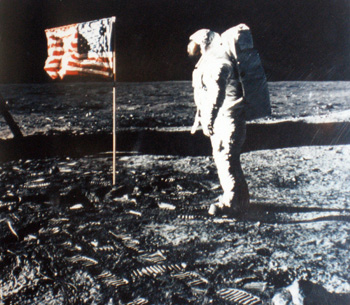 |
The Military Aviation Department has Legend, Memory, and the Great War in the Air (Gallery 206), showing a fighter aircraft and a bomber from World War I, World War II Aviation (Gallery 205), which covers allied and Axis fighters from five countries, Sea-Air Operations (Gallery 203) that includes aircraft carriers and information about the carrier war in the Pacific, and Jet Aviation (Gallery 106) which highlights World War II-era jet aircraft.
If space is a topic that you are just itching to know more about, then visit the Space Flight and Exploration section to be transported into a lifelike replica of space through galleries like Exploring the Planets (Gallery 207) that provides the most up to date information on solar system exploration, with the most precise photography of the planets and their surfaces.
Exploring the Moon (Gallery 112) showcases the very popular Apollo lunar module and lunar probes.
Discover artifacts from Mercury, Gemini, and Apollo in Apollo to the Moon (Gallery 210) and learn more about space suits and propulsion systems in Rocketry and Space Flight (Gallery 113), which displays space suits from the 1930s to today.
“Look how huge that suit is, that must be some production to get on,” laughed Mark Thompson, from Washington, D.C., to his wife as they stared at the space suits in the Rocketry and Space Flight gallery.
| The recovered Apollo 11 Command Module on display at the National Air and Space Museum (Photo by Danielle Cohn). | 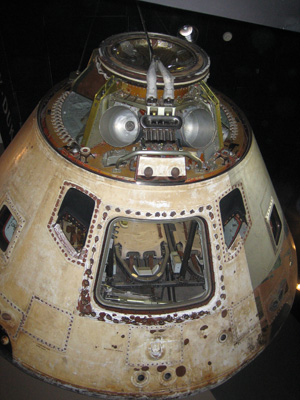 |
If your head feels like it’s going to explode from the overwhelming amount of information in this museum, feel free to take some edge off by enjoying one of the offered Simulator Rides where you can either go on a space walk, be a fighter pilot in aerial combat, take off in an F-18 Super Hornet or go on a dazzling journey through the cosmos on the Cosmic Coaster.
Visitors can also take in a show at the Albert Einstein Planetarium in the museum.
However, if you should just want to reserve the thrill for your eyes you can also indulge in the current showings at the Imax theater also located within the museum where you can rove the planet Mars, Walk on the Moon 3D or take off in an 1800s balloon across the Arizona skies.
Whatever one’s fantasy might be, it will surely be met within the walls of this museum. There is so much to keep anyone occupied from age five to ninety-five and visitors will leave feeling a part of something big and awesome.
“I could have never imagined that this place could hold as much stuff as it does. I have always loved space and even though I will never be an astronaut, today I have to say, I kind of feel like one,” said Ron Parker as he left the museum.
If You Go
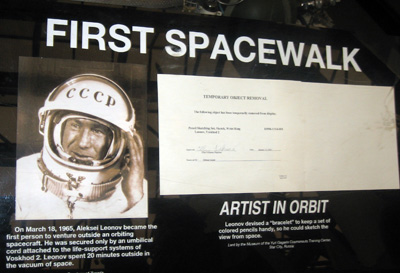 Location: 6th Street at Independence Avenue, SW, Washington, D.C. It is located at the National Mall between 4th and 7th Streets, near the U.S. Capitol.
Location: 6th Street at Independence Avenue, SW, Washington, D.C. It is located at the National Mall between 4th and 7th Streets, near the U.S. Capitol.- Hours: 10 a.m. to 5:30 p.m. daily (closed Dec. 25).
- Telephone: 202-633-1000.
- Web site: http://www.nasm.si.edu.
- Metro: L’Enfant Plaza (Orange, Blue, Yellow and Green Lines).

Comments are Closed